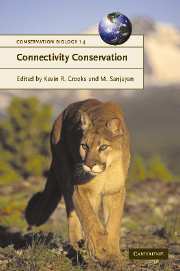Book contents
- Frontmatter
- Contents
- List of contributors
- Acknowledgements
- 1 Connectivity conservation: maintaining connections for nature
- PART I Approaches to connectivity research
- PART II Assessing connectivity
- Introduction: evaluating and quantifying the conservation dividends of connectivity
- 12 Quantifying connectivity: balancing metric performance with data requirements
- 13 Assessing connectivity in salmonid fishes with DNA microsatellite markers
- 14 Individual-based modeling as a tool for conserving connectivity
- 15 Linking connectivity to viability: insights from spatially explicit population models of large carnivores
- 16 Impacts of corridors on populations and communities
- 17 Exploring the functional connectivity of landscapes using landscape networks
- PART III Challenges and implementation of connectivity conservation
- Index
- References
14 - Individual-based modeling as a tool for conserving connectivity
Published online by Cambridge University Press: 24 May 2010
- Frontmatter
- Contents
- List of contributors
- Acknowledgements
- 1 Connectivity conservation: maintaining connections for nature
- PART I Approaches to connectivity research
- PART II Assessing connectivity
- Introduction: evaluating and quantifying the conservation dividends of connectivity
- 12 Quantifying connectivity: balancing metric performance with data requirements
- 13 Assessing connectivity in salmonid fishes with DNA microsatellite markers
- 14 Individual-based modeling as a tool for conserving connectivity
- 15 Linking connectivity to viability: insights from spatially explicit population models of large carnivores
- 16 Impacts of corridors on populations and communities
- 17 Exploring the functional connectivity of landscapes using landscape networks
- PART III Challenges and implementation of connectivity conservation
- Index
- References
Summary
INTRODUCTION
Animal movement
Functional (or behavioral) connectivity has been defined as “the degree to which the landscape facilitates or impedes movement among resource patches” (Taylor et al. 1993; Forman 1997; Taylor et al. Chapter. 2). When an animal moves, it must expend energy and it may take risks such as being more visible to predators. So why should an animal move at all? The reason is that the landscape in immediate proximity to an animal may not satisfy its present or anticipated needs. Therefore, we would expect movement to have some purpose for animals; in other words, it is a goal-oriented and behavior-mediated search. Bell (1990) suggests three factors that determine searching behavior: the characteristics and abilities of the animal, the resources and risks in the external environment, and resource requirements as determined by the internal state of the animal. We could think of movement as an activity that allows an animal to match its internal needs to its external environment: if it is threatened it finds safety, if it is hungry it finds food, if it is cold it finds warmth, and if it is ready to reproduce it finds a mate. An animal, however, must weigh all of these needs simultaneously each time it moves based on which needs are most important and what it knows about the landscape. An ordered set of these decisions, which results in a movement path, determines in large part the success of the individual.
- Type
- Chapter
- Information
- Connectivity Conservation , pp. 343 - 368Publisher: Cambridge University PressPrint publication year: 2006
References
- 15
- Cited by

